Controlling Segregation Behavior of Primary Si in Hypereutectic Al-Si Alloy by Electromagnetic Stirring
Abstract
1. Introduction
2. Experimental Procedure
2.1. The Separation Condition of Primary Si
2.2. The Separation Process of Primary Si
3. Results and Discussion
3.1. Electromagnetic Separation Condition of Primary Si
3.1.1. Effect of Temperature Field on the Segregation Behavior of Primary Si
3.1.2. Role of Electromagnetic Stirring in the Separation Process of Primary Si
3.2. Electromagnetic Separation Process of Primary Si
3.2.1. The Transport Behavior of Primary Si under Electromagnetic Stirring
3.2.2. Electromagnetic Separation Mechanism of Primary Si
3.3. Application Exploration of Electromagnetic Separation of Primary Si
3.3.1. The Preparation of In-Situ Particle Reinforced Al-Base Gradient Composites
3.3.2. The Purification of Metallurgical Grade Si
4. Conclusions
- The temperature field and fluid flow in the melt are two key points for controlling the segregation behavior of primary Si. The establishment of a temperature gradient in the Al-Si melt was determined to be a precondition for realizing the separation of primary Si. Electromagnetic stirring can further strengthen the separation effect of primary Si on the basis of the temperature gradient.
- The formation of a Si-rich layer is based on the continuous growth of primary Si via the absorption of Si atoms from the Al-Si melt with the help of secondary flow. The Al-rich melt can be squeezed out in the Si-rich layer under the centrifugal effect of the primary flow, resulting in an increasing mass fraction of primary Si up to 65~70 wt.% under a magnetic intensity of 25 mT.
- Based on an understanding of the separation mechanism, the segregation control of primary Si can be achieved successfully by coupling the temperature gradient and electromagnetic stirring. The separation technology for primary Si reported in this study not only presents a new design concept for hypereutectic Al-Si in-situ graded gears for the fields of astronautics and aeronautics, but also proposes a new energy-saving strategy to provide low-cost SOG-Si for the solar photovoltaic industry.
Author Contributions
Funding
Conflicts of Interest
References
- Zou, M.; Zhao, D.G.; Wang, Z.Q.; Geng, H.R. Complex modification of hypereutectic Al-Si alloy by a new Al-Y-P master alloy. Met. Mater. Int. 2015, 21, 646–651. [Google Scholar]
- Wang, R.Y.; Lu, W.H.; Hogan, L.M. Microstructure-strengthening interrelationship of an ultrasonically treated hypereutectic Al-Si (A390) alloy. Met. Mater. Int. 2018, 24, 1376–1385. [Google Scholar]
- Mao, F.; Wei, S.Z.; Chen, C.C.; Zhang, C.; Wang, X.D.; Cao, Z.Q. Modification of the silicon phase and mechanical properties in Al-40Zn-6Si alloy with Eu addition. Mater. Des. 2020, 186, 108268. [Google Scholar] [CrossRef]
- Jin, F.W.; Ren, Z.M.; Ren, W.L.; Deng, K.; Zhong, Y.B.; Yu, J.Y. Effects of a high-gradient magnetic field on the migratory behavior of primary crystal silicon in hypereutectic Al-Si alloy. Sci. Technol. Adv. Mater. 2008, 9, 024202. [Google Scholar] [CrossRef] [PubMed]
- Zhang, Z.T.; Li, T.J.; Yue, H.Y.; Zhang, J.; Li, J. Study on the preparation of Al-Si functionally graded materials using power ultrasonic field. Mater. Des. 2009, 30, 851–856. [Google Scholar] [CrossRef]
- Li, J.W.; Guo, Z.C.; Tang, H.Q.; Wang, Z.; Sun, S.T. Si purification by solidification of Al-Si melt with super gravity. Trans. Nonferr. Met. Soc. China 2012, 22, 958–963. [Google Scholar] [CrossRef]
- Zhang, Y.H.; Miao, X.C.; Shen, Z.Y.; Han, Q.Y.; Song, C.J.; Zhai, Q.J. Macro segregation formation mechanism of the primary silicon phase in directionally solidified Al-Si hypereutectic alloys under the impact of electric currents. Acta Mater. 2015, 97, 357–366. [Google Scholar] [CrossRef]
- Li, J.Y.; Ni, P.; Wang, L.; Tan, Y. Influence of direct electric current on solidification process of Al-Si alloy. Mater. Sci. Semicond. Process. 2017, 61, 79–84. [Google Scholar] [CrossRef]
- Zhang, Y.H.; Ye, C.Y.; Xu, Y.Y.; Zhong, H.G.; Chen, X.R.; Miao, X.C.; Song, C.J.; Zhai, Q.J. Influence of growth velocity on the separation of primary silicon in solidified Al-Si hypereutectic alloy driven by a pulsed electric current. Metals 2017, 7, 184. [Google Scholar] [CrossRef]
- Shen, Z.; Zhou, B.F.; Zhong, Y.B.; Zheng, T.; Ren, W.; Lei, Z.; Ren, Z. Revealing influence mechanism of a transverse static magnetic field on the refinement of primary dendrite spacing during directional solidification. J. Cryst. Growth 2019, 517, 54–58. [Google Scholar] [CrossRef]
- Takeshi, Y.; Morita, K. Refining of silicon during its solidification from a Si-Al melt. J. Cryst. Growth 2019, 311, 776–779. [Google Scholar]
- Takeshi, Y.; Morita, K. Continuous solidification of Si from Si-Al Melt under the induction heating. ISIJ Int. 2007, 47, 582–584. [Google Scholar]
- Takeshi, Y.; Morita, K. Refining of Si by the solidification of Si-Al melt with electromagnetic force. ISIJ Int. 2007, 45, 967–971. [Google Scholar]
- He, Y.F.; Ma, W.H.; Lv, G.Q.; Zhang, Y.F.; Lei, Y.; Yang, X. An efficient method to separate silicon from high-silicon aluminum alloy melts by electromagnetic directional solidification. J. Clean. Prod. 2018, 185, 389–398. [Google Scholar] [CrossRef]
- Bai, X.L.; Ban, B.Y.; Li, J.W.; Fu, Z.Q.; Peng, Z.J.; Wang, C.B.; Chen, J. Effect of Ti addition on B removal during silicon refining in Al-30%Si alloy directional solidification. Sep. Purif. Technol. 2017, 147, 345–351. [Google Scholar] [CrossRef]
- Chen, K.; Chen, X.H.; Lei, Y.; Ma, W.H.; Han, J.X.; Yang, Z.H. Mechanism of enhancing B removal from Si with V addition using Al-Si as the refining solvent. Sep. Purif. Technol. 2018, 203, 168–177. [Google Scholar] [CrossRef]
- Yu, W.Z.; Ma, W.H.; Lv, G.Q.; Ren, Y.S.; Xue, H.Y.; Dai, Y.N. Si purification by enrichment of primary Si in Al-Si melt. Trans. Nonferr. Met. Soc. China 2013, 23, 3476–3481. [Google Scholar] [CrossRef]
- Yu, W.Z.; Ma, W.H.; Lv, G.Q.; Xue, H.Y.; Li, S.Y.; Dai, Y.N. Effect of electromagnetic stirring on the enrichment of primary silicon from Al-Si melt. J. Cryst. Growth 2014, 405, 23–28. [Google Scholar] [CrossRef]
- Jie, J.C.; Zou, Q.C.; Wang, H.W.; Sun, J.L.; Lu, Y.P.; Wang, T.M.; Li, T.J. Separation and purification of Si from solidification of hypereutectic Al-Si melt under rotating magnetic field. J. Cryst. Growth 2014, 399, 43–48. [Google Scholar] [CrossRef]
- He, Y.; Li, Q.; Liu, W. Effect of combined magnetic field on the eliminating inclusions from liquid aluminum alloy. Mater. Lett. 2011, 65, 1226–1228. [Google Scholar] [CrossRef]
- Zou, J.; Zhai, Q.J.; Liu, F.Y.; Liu, K.M.; Lu, D.P. Influences on distribution of solute atoms in Cu-8Fe alloy solidification process under rotating magnetic field. Met. Mater. Int. 2018, 24, 1275–1284. [Google Scholar] [CrossRef]
- Mikolajczak, P.; Ratke, L. Effect of stirring induced by rotating magnetic field on β-Al5FeSi intermetallic phases during directional solidification in Al-Si alloys. Int. J. Cast Met. Res. 2013, 26, 339–353. [Google Scholar] [CrossRef]
- Lyubimova, T.P.; Ivantsov, M.A.; Khlybov, A.O.; Khlybov, O.; Zaidat, K.; Duffar, T. Influence of submerged heating on vertical Bridgman crystal growth of silicon under travelling magnetic field. J. Cryst. Growth 2019, 531, 125340. [Google Scholar] [CrossRef]
- Ren, Z.M.; Jin, J.Z. Formation of a separated eutectic in Al-Si eutectic alloy. J. Mater. Sci. 1992, 27, 4663–4666. [Google Scholar]
- Ban, B.Y.; Li, Y.L.; Zuo, Q.X.; Zhang, T.T.; Chen, J.; Dai, S.Y. Refining of metallurgical grade Si by solidification of Al-Si melt under electromagnetic stirring. J. Mater. Process. Technol. 2015, 222, 142–147. [Google Scholar] [CrossRef]
- Ban, B.Y.; Zhang, T.T.; Li, J.W.; Bai, X.L.; Pan, X.; Chen, J.; Tabaian, S.H. Solidification refining of MG-Si by Al-Si alloy under rotating electromagnetic field with varying frequencies. Sep. Purif. Technol. 2018, 202, 266–274. [Google Scholar] [CrossRef]
- Zou, Q.C.; Jie, J.C.; Sun, J.L.; Wang, T.M.; Cao, Z.Q.; Li, T.J. Effect of Si content on separation and purification of the primary Si phase from hypereutectic Al-Si alloy using rotating magnetic field. Sep. Purif. Technol. 2015, 142, 101–107. [Google Scholar] [CrossRef]
- Zou, Q.C.; Jie, J.C.; Liu, S.C.; Sun, X.L.; Li, T.J.; Wang, T.M.; Yin, G.M. Effect of Sn addition on the separation and purification of primary Si from solidification of Al-30Si melt under electromagnetic stirring. J. Alloy. Compd. 2017, 725, 1264–1271. [Google Scholar] [CrossRef]
- Xue, H.Y.; Lv, G.Q.; Ma, W.H.; Chen, D.T.; Yu, J. Separation mechanism of primary silicon from hypereutectic Al-Si melts under alternating electromagnetic fields. Metall. Mater. Trans. A 2015, 46, 2092–2103. [Google Scholar] [CrossRef]
- Jiang, W.Y.; Yu, W.Z.; Li, J.; You, Z.X.; Li, C.M.; Lv, X.W. Segregation and morphological evolution of Si phase during electromagnetic directional solidification of hypereutectic Al-Si alloys. Materials 2019, 12, 10. [Google Scholar] [CrossRef]
- Liang, S.M.; Fetzer, R.S. Phosphorus in Al-Si cast alloys: Thermodynamic prediction of the AlP and eutectic (Si) solidification sequence validated by microstructure and nucleation undercooling data. Acta Mater. 2014, 72, 41–56. [Google Scholar] [CrossRef]
- Zou, Q.C.; Han, N.; Zhang, Z.X.; Jie, J.C.; Xu, F.; An, X.Z. Enhancing segregation behavior of impurity by electromagnetic stirring in the solidification process of Al-30Si alloy. Metals 2020, 10, 155. [Google Scholar] [CrossRef]
- Jie, J.C.; Liu, C.B.; Wang, S.H.; Dong, B.W.; Liu, S.C.; Li, T.J. Characterisation of steel/nickel bronze clad strips prepared by continuous solid/liquid bonding method. Mater Sci Technol. 2019, 35, 1840–1847. [Google Scholar] [CrossRef]
- Zou, Q.C.; Jie, J.C.; Wang, T.M.; Li, T.J. An efficient method to purify metallurgical grade Si by electromagnetic semi-continuous casting of Al-30Si melt. Mater Lett. 2016, 185, 59–62. [Google Scholar] [CrossRef]
- Won, C.W.; Nersisyan, H.H.; Won, H.I. Solar-grade silicon powder prepared by combining combustion synthesis with hydrometallurgy. Sol. Energy Mater. Sol. Cells 2019, 57, 45–750. [Google Scholar] [CrossRef]
- Fang, M.; Lu, C.H.; Huang, L.Q.; Lai, H.X.; Chen, J.; Li, J.T.; Ma, W.H.; Xing, P.F.; Luo, X.T. Separation of metal impurities from metallurgical grade silicon via CaO-SiO2-CaF2 slag treatment followed by leaching with hydrochloric acid. Sep. Purif. Technol. 2014, 49, 2261–2270. [Google Scholar]
- Ding, Z.; Ma, W.H.; Wei, K.X.; Wu, J.J.; Zhou, Y.; Xie, K.Q. Boron removal from metallurgical-grade silicon using lithium containing slag. J. Non-Cryst. Solids 2012, 358, 2708–2712. [Google Scholar] [CrossRef]
- Zhang, L.; Tan, Y.; Li, J.Y.; Liu, Y.; Wang, D.K. Study of boron removal from molten silicon by slag refining under atmosphere. Mat. Sci. Semicond. Proc. 2013, 16, 1645–1649. [Google Scholar] [CrossRef]
- Yuge, N.; Abe, M.; Hanazawa, K.; Baba, H.; Naomichi, N.; Yoshiei, K.; Yutaku, S.; Hiwasa, S.; Aratani, F. Purification of metallurgical-grade silicon up to solar grade. Prog. Photovolt. 2001, 9, 203–209. [Google Scholar] [CrossRef]
- Shi, S.; Dong, W.; Peng, X.; Jiang, D.C.; Tan, Y. Evaporation and removal mechanism of phosphorus from the surface of silicon melt during electron beam melting. Appl. Surf. Sci. 2013, 266, 344–349. [Google Scholar] [CrossRef]
- Martorano, M.A.; Ferreira Neto, J.B.; Oliveira, T.S.; Tsubaki, T.O. Refining of metallurgical silicon by directional solidification. Mater. Sci. Eng. B 2011, 176, 217–226. [Google Scholar] [CrossRef]
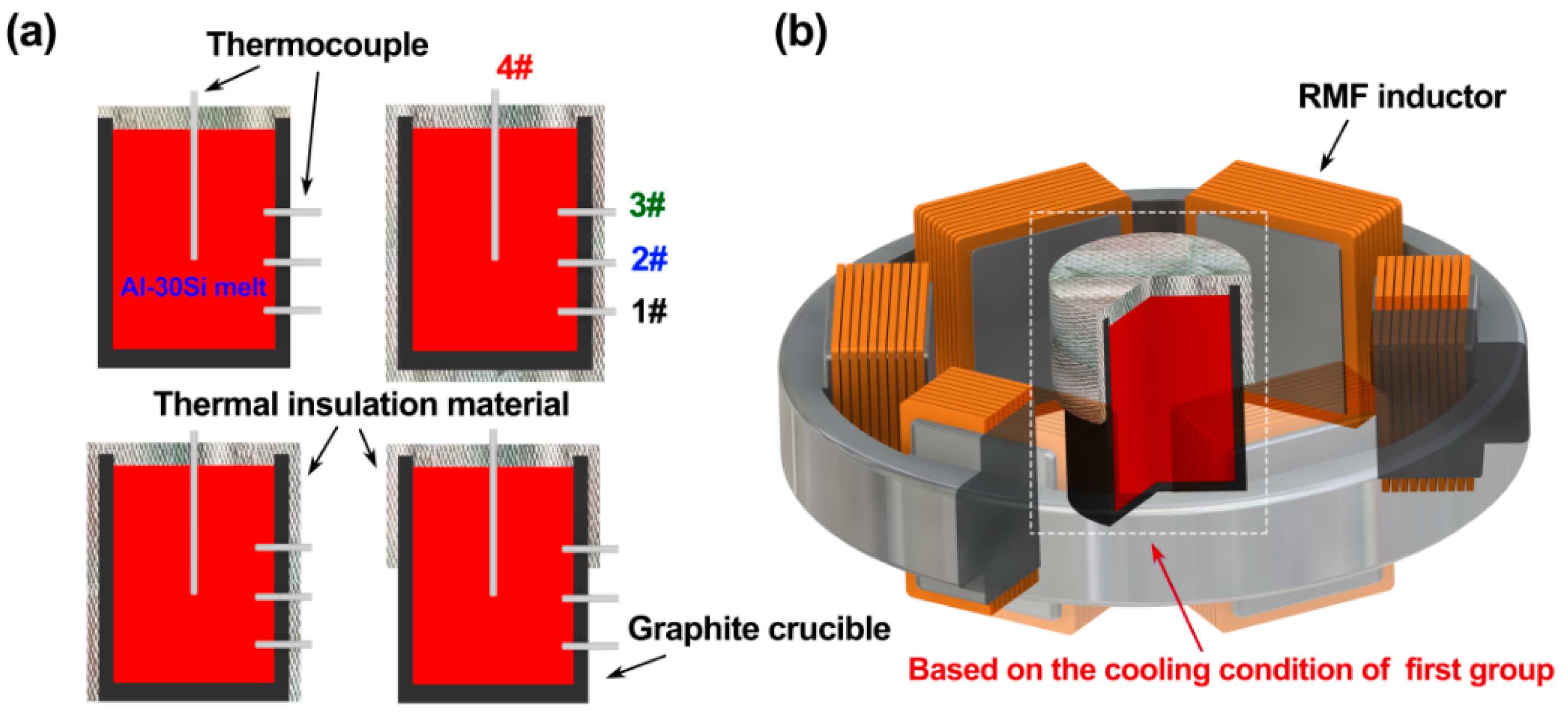
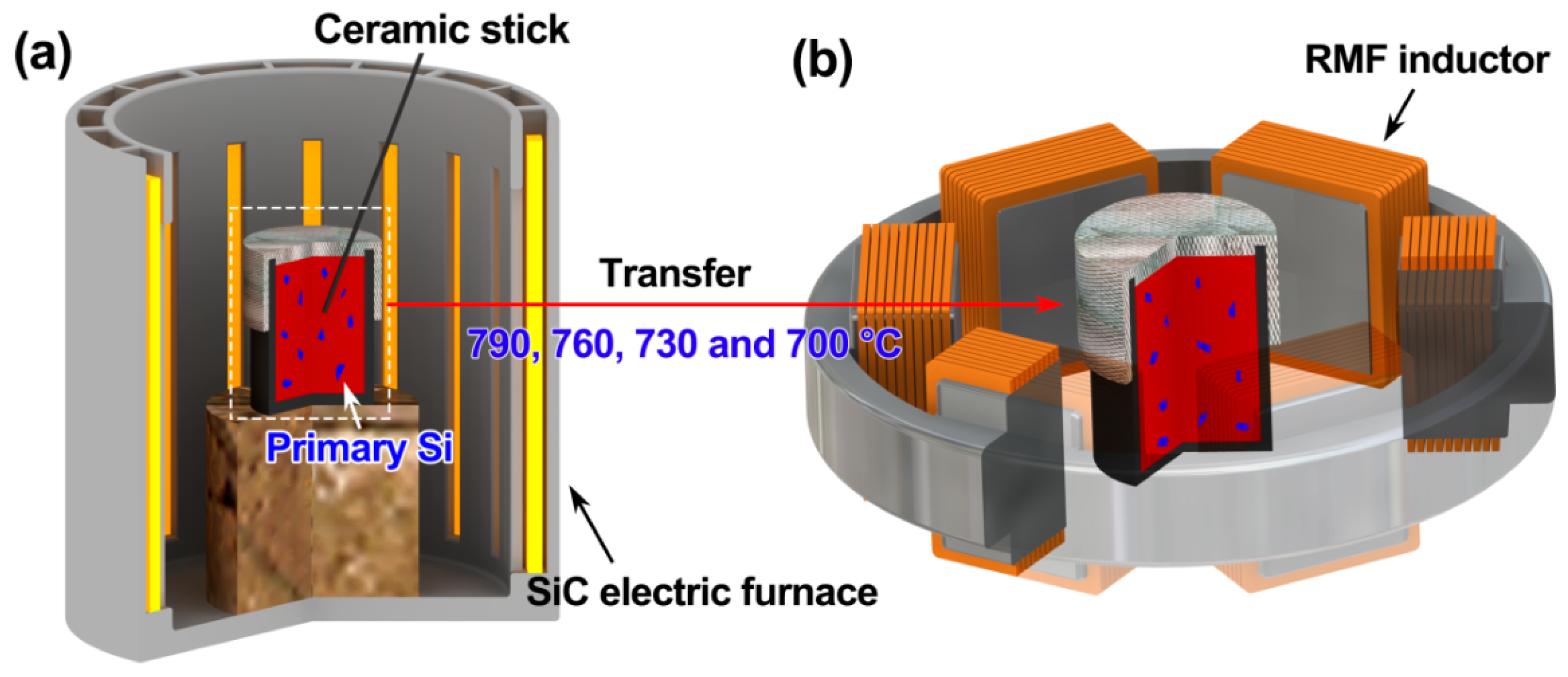
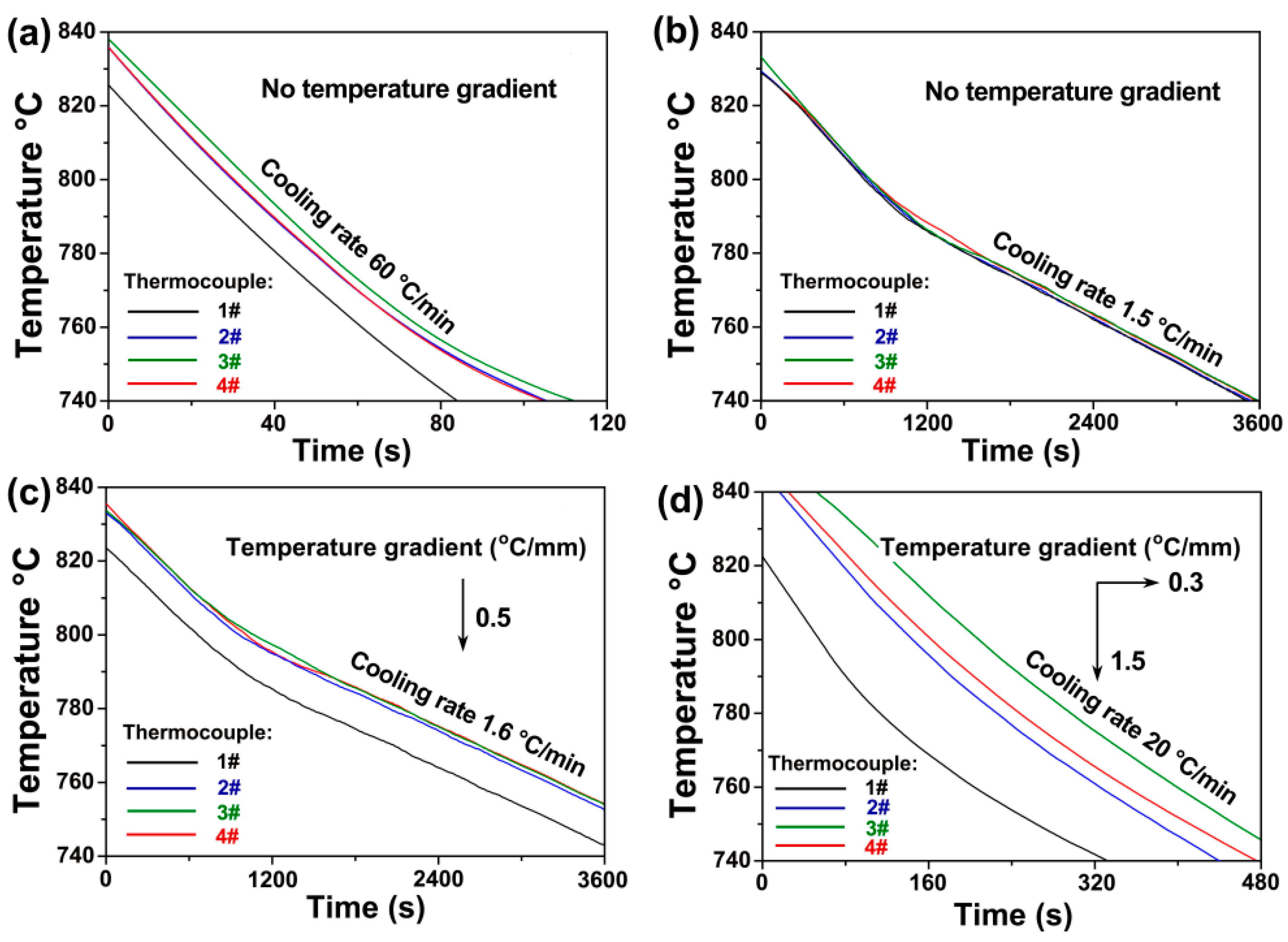
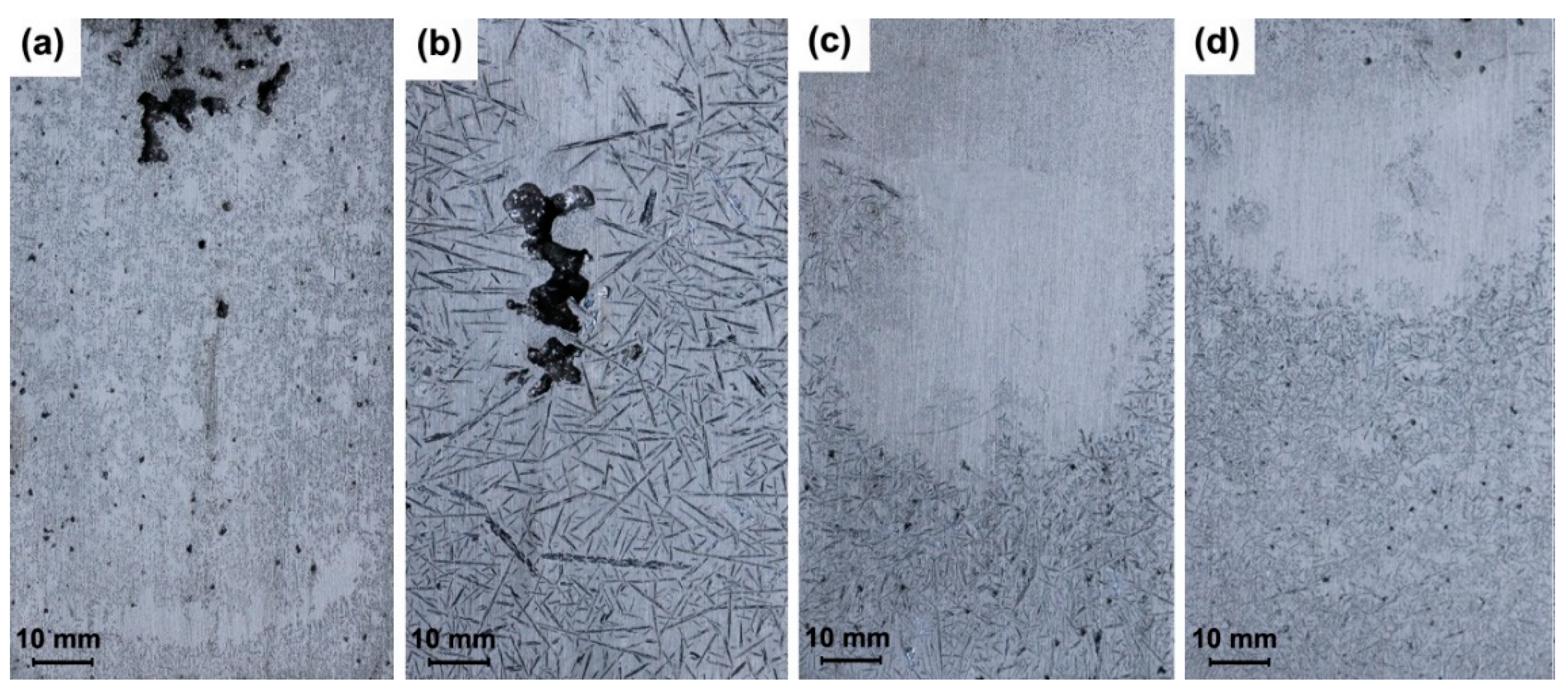
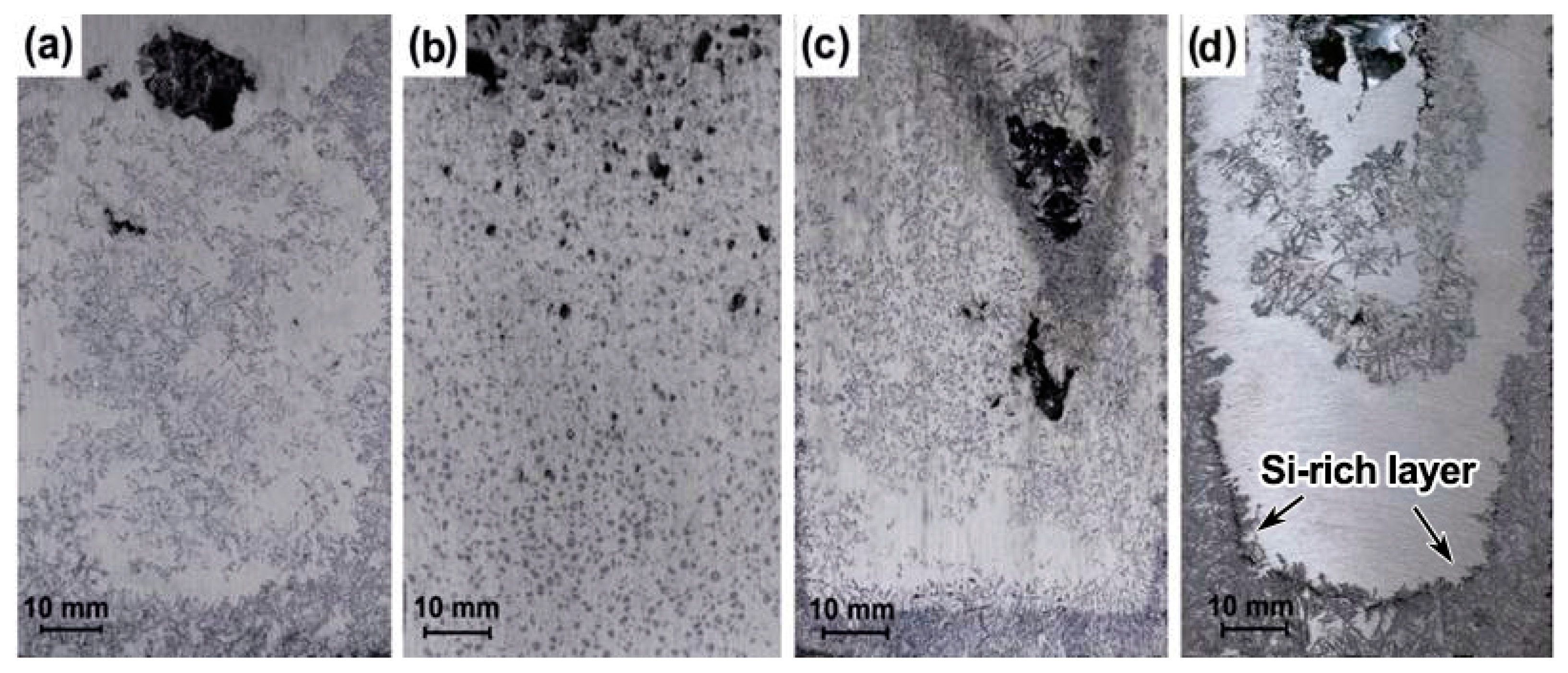
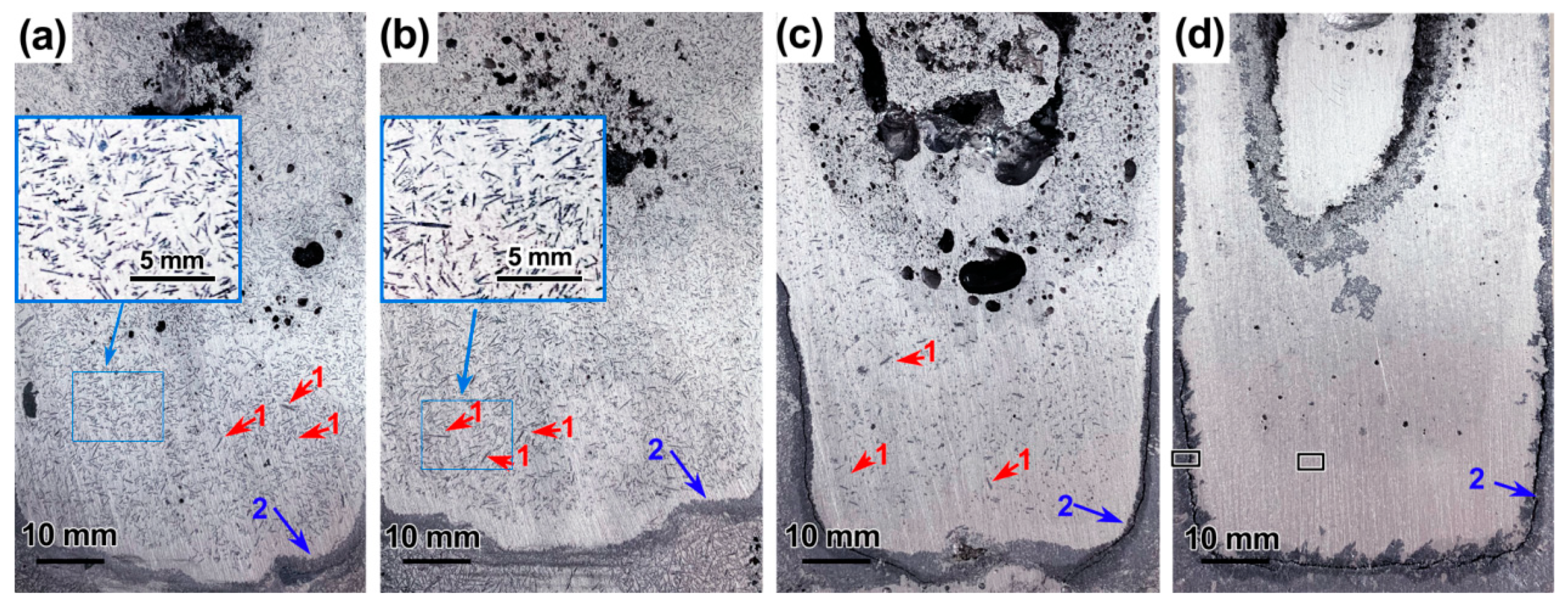

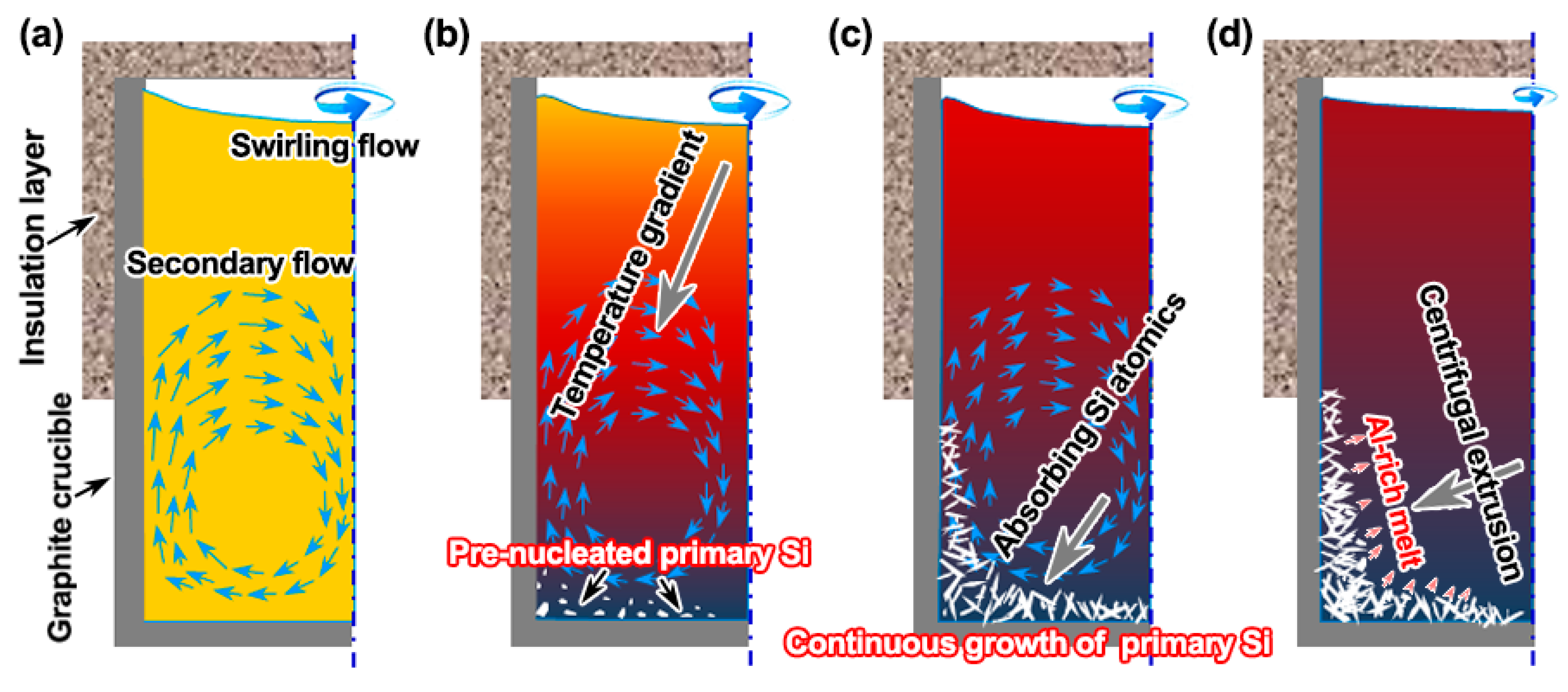
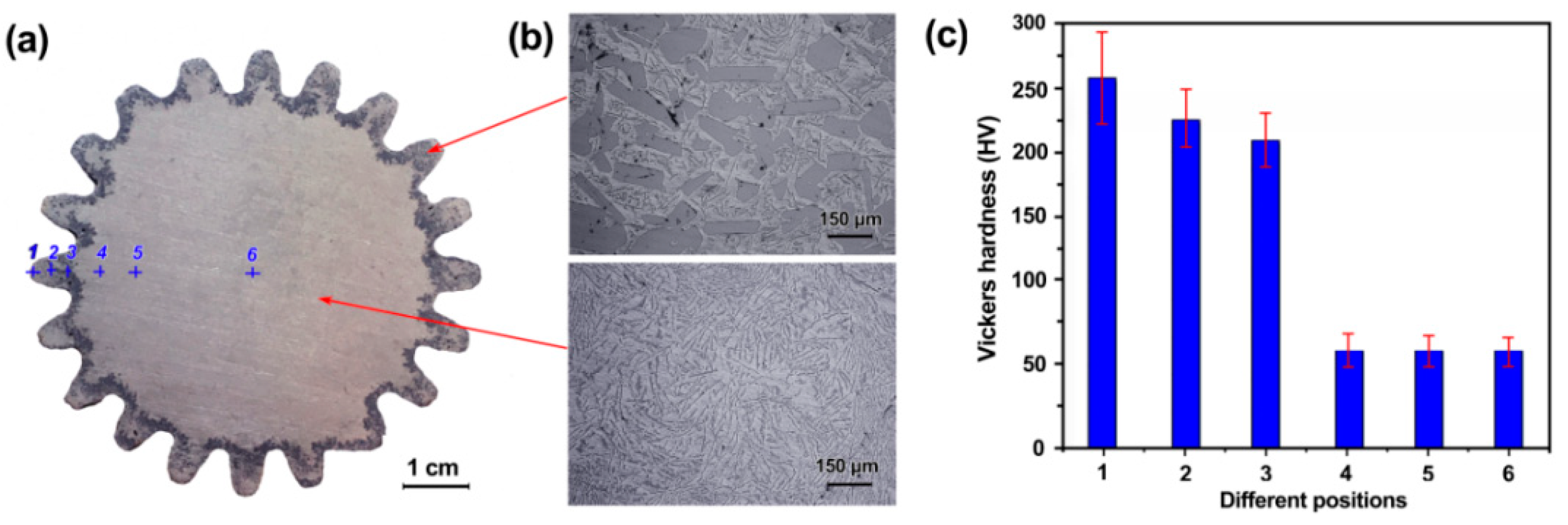
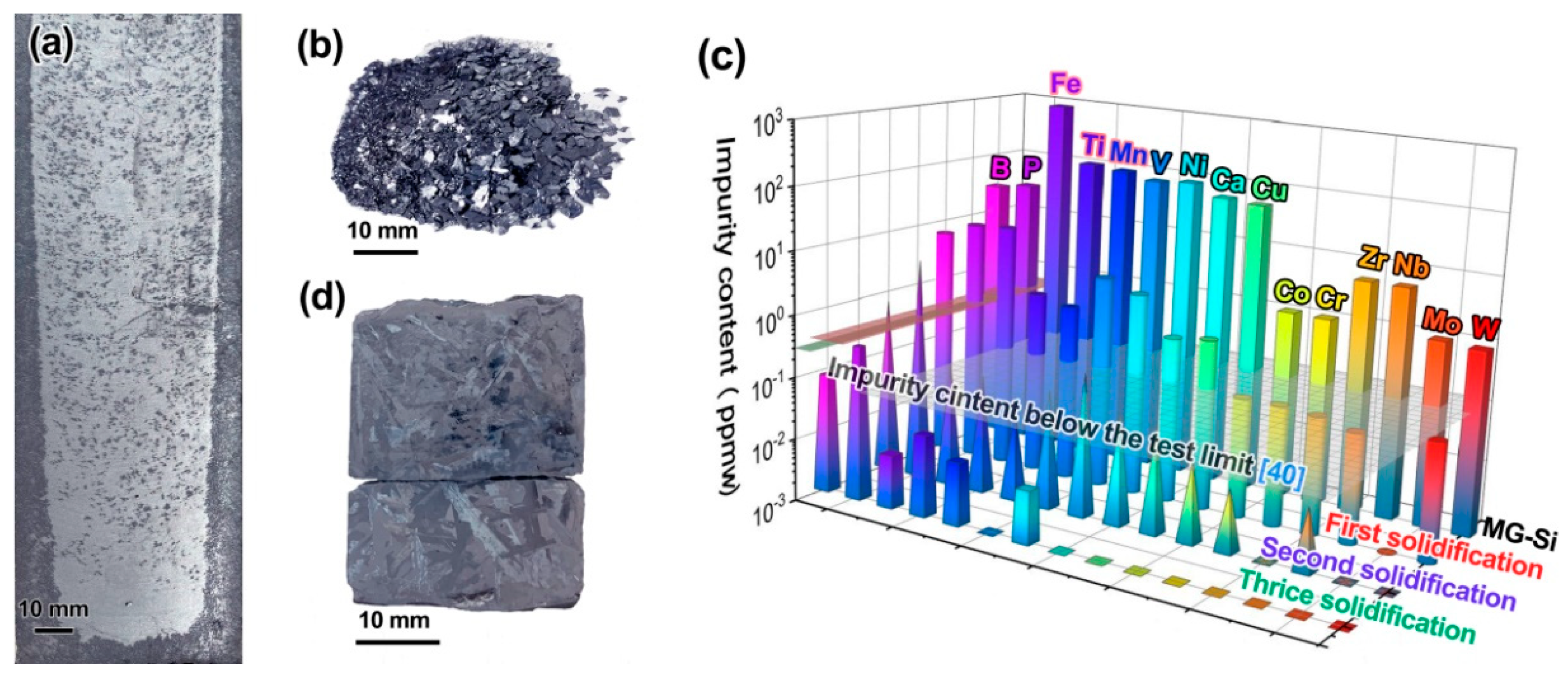
| Groups | Temperature Field | Electromagnetic Stirring | Experiment Objective | ||
|---|---|---|---|---|---|
| Temperature Gradient | Cooling Rate | ||||
| First group | CI-1 | Uniform | Fast | Without RMF | The influence of the cooling rate on the segregation behavior of primary Si was investigated under a uniform temperature field. |
| CI-2 | Slow | ||||
| CI-3 | Uneven | Fast | The influence of the temperature gradient on the segregation behavior of primary Si was determined after eliminating the influence factors of the cooling rate. | ||
| CI-4 | Slow | ||||
| Second group | CII-1 | Uniform | Fast | With RMF | The purpose was to investigate whether or not electromagnetic force plays a decisive role on the transport behavior of primary Si under a uniform temperature field with a different cooling rate. |
| CII-2 | Slow | ||||
| CII-3 | Uneven | Fast | The effect of melt flow forced by the RMF on the separation of primary Si was investigated on the basis of confirming the role of electromagnetic force. | ||
| CII-4 | Slow | ||||
| Purification Method | Purification Process | Objective/ppmw [35] | Impurity Contents in Si after Each Refining/ppmw | Rf. | |||
|---|---|---|---|---|---|---|---|
| Once | Twice | Thrice | |||||
| Traditional metallurgical process | First step: Slag refining to remove B | Na2O-SiO2, temperature: 1700 °C, 30 min | <0.3 | 24 → 0.8 | 0.8 → 0.4 | 0.4 → 0.1 | [36] |
| CaO-SiO2-LiF, temperature: 1550 °C, 240 min CaO-SiO2-Li2O, temperature: 1550 °C, 240 min | 22 → 3.3 24 → 3.6 | [37] | |||||
| CaF2-Al2O3-CaO-SiO2, temperature: 1800 °C, 240 min | 25 → 5.1 | 5.1 → 2.6 | [38] | ||||
| Second step: Vacuum plasma refining to remove P | Power: 200 kW | <0.5 | 25 → <0.1 | [39] | |||
| Vacuum degree: 10−2~10−3Pa, Power: 21 kW, 30 min Vacuum degree: 5 × 10−2 Pa, Power: 30 kW, 30 min | 15 → <0.1 33 → <0.1 | [40] | |||||
| Third step: Directional solidification to remove the metallic | Temperature: 1414 °C, Solidification rate: 0.6 mm/min | <0.1 | Fe 2800 → 0.29 Ti 140 → <0.1 | [41] | |||
| Power: 600 kW, Solidification rate: 0.6 mm/min Power: 800 kW, Solidification rate: 0.18 mm/min | Fe 1000 → <10 Ti 200 → <10 | Fe < 10 → <0.1 Ti < 10 → <0.1 | [39] | ||||
| In this work | Continuous separation technique of primary Si | Casting temperature: 950 °C Magnetic flux density: 35 mT Electromagnetic frequency: 50 Hz Casting speed: 50 mm/min | <0.3 <0.5 <0.1 | B 21.2 → 4.3 P 38.5 → 11.2 Fe 987 → <10.6 Ti 110 → <1.3 | 4.3 → 0.8 11.2 → 3.8 10.6 → <0.1 1.3 → <0.1 | 0.8 → <0.1 3.8 → 0.3 | |
© 2020 by the authors. Licensee MDPI, Basel, Switzerland. This article is an open access article distributed under the terms and conditions of the Creative Commons Attribution (CC BY) license (http://creativecommons.org/licenses/by/4.0/).
Share and Cite
Zou, Q.; Tian, H.; Zhang, Z.; Sun, C.; Jie, J.; Han, N.; An, X. Controlling Segregation Behavior of Primary Si in Hypereutectic Al-Si Alloy by Electromagnetic Stirring. Metals 2020, 10, 1129. https://doi.org/10.3390/met10091129
Zou Q, Tian H, Zhang Z, Sun C, Jie J, Han N, An X. Controlling Segregation Behavior of Primary Si in Hypereutectic Al-Si Alloy by Electromagnetic Stirring. Metals. 2020; 10(9):1129. https://doi.org/10.3390/met10091129
Chicago/Turabian StyleZou, Qingchuan, Hao Tian, Zixu Zhang, Chengzhuo Sun, Jinchuan Jie, Ning Han, and Xizhong An. 2020. "Controlling Segregation Behavior of Primary Si in Hypereutectic Al-Si Alloy by Electromagnetic Stirring" Metals 10, no. 9: 1129. https://doi.org/10.3390/met10091129
APA StyleZou, Q., Tian, H., Zhang, Z., Sun, C., Jie, J., Han, N., & An, X. (2020). Controlling Segregation Behavior of Primary Si in Hypereutectic Al-Si Alloy by Electromagnetic Stirring. Metals, 10(9), 1129. https://doi.org/10.3390/met10091129







